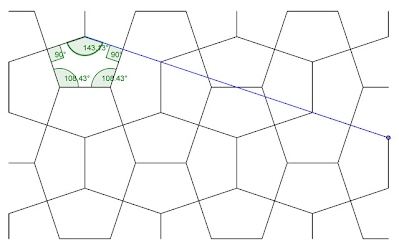Introduction As can be seen by the various studies, there are a multiplicity of examples that are, loosely defined, as ‘Cairo-like’ (with a pentagon of two non-adjacent angles that are 90°). However, aesthetically, these differ, some of these are ‘better’, or are of more interest, due to their inherent mathematical properties. This page thus collects these, and examines their properties. 1. Equilateral pentagon (114° 18’, 131° 24’) Fig.1 Aesthetically
this is very pleasing indeed, and arguably this is the ‘best’ pentagon in the
series, not only here of the 1 pentagon category but the series as a whole, in
that it is the most ‘basic’ of all the pentagon types, in that it possesses the
most symmetry, namely of all five sides the same length, of which I consider
the overriding issue as regards aesthetics. (The other examples in the series
here can be described, at least in comparison, as weaker, with different side
lengths). Indeed, this is my own personal favourite. Such aesthetics probably
account for its popularity as the frequently stated serving model, likely from Gardner’s
account (MacMahon also gives this). However, it does posses one relative
shortcoming, in that it does not possess collinearity of others, namely. 2.
Dual of the 32. 4. 3. 4 (120°) Aesthetically this is very pleasing indeed, and
arguably, the second ‘best’ pentagon in the series, due to its underlying
background, namely that of the dual of the semi-regular 32.4. 3. 4
tiling. However, I consider that it pales aesthetically, in relative terms, as
when compared with the equilateral, in that the major shortcoming is the sides
lack those all of the same length. (In contrast to the equilateral pentagon,
the sides not of the same length, with four of these being the same, with one
decidedly ‘short’ in relation to the other four, described as of the ‘4, 1
short’ type (in contrast to ‘4, 1 long’, to others which is also possible) But
that said, due to its underlying source it still has much aesthetic value.
Furthermore, it has ‘pleasing’, round figure, ‘aesthetic’ interior angles, two
of 90°, and three of 120°, something which the other ‘core value’ examples
lack. Also lacking is collinearity. Another factor in its favour is that it is of a 'average' pentagon, the mid point between the minimum (rectangle) and maximum (square) conditions as set out by Macmillan. Again, as above with the equilateral,
likely on account of its many aesthetics, many authors cite this as the defining
model.
3. Cordovan, by Redondo
and Reyes (112.5°,
135°) Fig. 3 Aesthetically pleasing, with a collinearity feature; when the sides are so produced it results in the ‘nearest neighbour’ pentagon in a like orientation intersecting at a nearest vertex. However, in matters of collinearity I still consider the side collinearity as a superior aspect. Surprisingly, this particular pentagon is very little known, with apparently only Redondo and Reyes having written about this, in relation to their studies of the Cordovan proportion, hence the title.
4: Bailey (105°, 150°)
 Fig. 4 Aesthetically pleasing, with a collinearity
feature; when the sides are so produced it results in the ‘nearest neighbour’
pentagon in a like orientation intersecting at a nearest vertex. However, in
matters of collinearity I still consider the side collinearity as a superior
aspect. Surprisingly, this particular pentagon is apparently completely known, found
by myself amongst my Cairo
studies, hence the attribution.
5. Squared Intersections (108° 43’, 143° 13’)
Fig. 5 Aesthetically, this is pleasing in regard as to the general resemblance to the serving model, and indeed is the strongest of its type; at a casual glance, they are indistinguishable. Indeed, as discussed elsewhere, this could possibly serve as the in situ model, with Macmillan having been mistaken. This example, based on the reflected stick figure premise, is remarkably like the in situ example, with convex pentagons, with near like angles (contrast 108° 26’, 143° 8’), same side proportions (4, 1), with collinearity, with convex subsidiary hexagons and a long base. Note that further examples of a similar stick cross premise/construction lack such close angles and this collinearity aspect.
This possesses most of the properties of the serving model, namely symmetrical, two 90° opposite angles, 4: 1 ratios, subsidiary convex par hexagons at right angles, collinearity, and a long base (the latter in relative terms). Indeed, it has all the same attributes!
Created 1 June 2012 |
Cairo Tiling >



